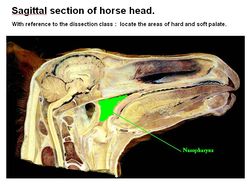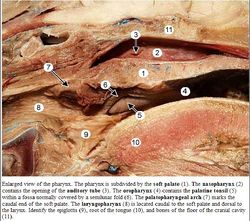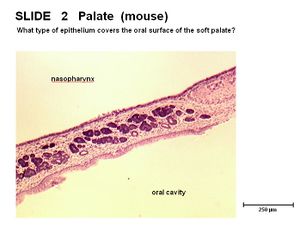Pharynx - Anatomy & Physiology
Introduction
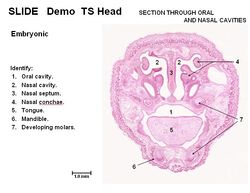
The pharynx is part of both the respiratory and digestive system. Both systems have entrances to the pharynx but they are separated from each other by the soft palate. During exercise or during respiratory distress, the mouth can be used as an additional opening of the respiratory system and then the oropharynx also becomes an air-way.
The pharynx can be split into different regions - the oropharynx, laryngeal pharynx (sometimes referred to as the oesophageal pharynx) and the nasopharynx.
Structure and Function
The opening of the larynx is on the floor of the pharynx. Caudal and dorsal to the laryngeal opening is the opening into the oesophagus. In the dorsal region of the nasopharynx, there are paired openings into the auditory (eustachian) tubes. The lining of the middle ear cavity and auditory tube is continuous with that of the nasopharynx. The pharynx is located between the base of the skull and the first two cervical vertebrae dorsally and the larynx ventrally. The mandible, pterygoid muscles and hyoid apparatus are located laterally. Laterally, two pairs of palatopharyngeal arches are present from the soft palate to the oesophagus.
The walls of the pharynx contain striated muscle. During swallowing, the soft palate is raised which divides the pharynx into dorsal and ventral sections. The dorsal compartment is the nasopharynx and the rostral compartment is the oropharynx. The laryngeal pharynx is separated from the oropharynx by the epiglottis. Tonsils are present on the lateral walls of the oropharynx and are covered by flaps of mucosa.
The pharynx plays an important role in deglutition.
Musculature
Pharyngeal muscles arise from arch 4 except for the stylopharyngeous muscle that comes from arch 3.
Muscles that constrict
Muscles that constrict the pharynx run dorsally to its roof. Rostral constrictor muscles are the hyopharyngeous, pterygopharyngeous and the palatopharyngeous muscles. They originate from the pterygoid region of the skull and insert on the aponeurosis of the soft palate and shorten the pharynx. The middle constrictor muscle is the thyopharyngeous muscle. It originates from the hyoid bone. Caudally is the cricopharyngeous muscle, which originates from the thyroid cartilage of the larynx.
Muscles that dilate
Muscles that dilate the pharynx enclose it laterally and dorsally. The dilator muscle is the stylopharyngeous muscle. It originates from the hyoid apparatus and widens the rostral pharynx.
Muscles that shorten
The pterygopharyngeal muscle and palatopharyngeal muscle shorten the pharynx. They enclose the pharynx laterally and dorsally.
Muscles that close the Pharyngeal Arch
The palatopharyngeous muscle also closes the pharyngeal arch.
Innervation
The nervous supply comes from the pharyngeal branch of the vagus nerve (CN X) and from the cranial root of the accessory nerve (CN XI). The stylopharyngeous muscle is innervated by the glossopharyngeal nerve (CN IX).
Histology
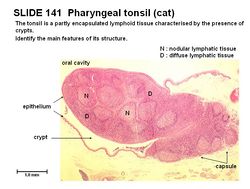
Fibroelastic aponeurosis supports the mucosa. The nasopharynx has pseudostratified columnar epithelium. The oropharynx and the laryngeal pharynx have stratified squamous epithelium. The oropharynx and the laryngeal pharynx also have salivary glands present.
Species Differences
Canine
A single duct connects the nasopharynx to the nasal cavity. The tonsils are a compact mass which point away from the lumen of the pharynx.
Equine
The auditory tube opens into the guttural pouch and the tonsils are diffuse and raised slightly. Horses are unable to breathe through the mouth as the free apex of the rostral epiglottis lies dorsal to the soft palate in a normal horse.
Ruminants
Tonsils are a compact mass which point towards the lumen of the pharynx.
Links
Click here for more information on the oropharynx.
Click here for more information on the laryngeal pharynx.
| Pharynx - Anatomy & Physiology Learning Resources | |
|---|---|
 Test your knowledge using flashcard type questions |
Oropharynx Anatomy & Physiology Flashcards Facial muscles Pharynx Laryngeal pharynx Nasal pharynx |
 Selection of relevant PowerPoint tutorials |
Histology of the pharynx and larynx Histology of lymphoid tissue, including the pharyngeal tonsils |
Anatomy Museum Resources |
Plastinated Dog Pharynx In Situ |
| This article has been peer reviewed but is awaiting expert review. If you would like to help with this, please see more information about expert reviewing. |
Webinars
Failed to load RSS feed from https://www.thewebinarvet.com/gastroenterology-and-nutrition/webinars/feed: Error parsing XML for RSS
